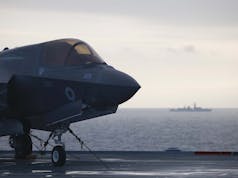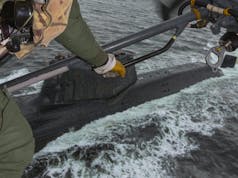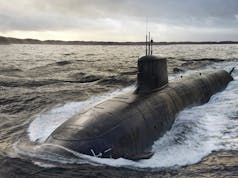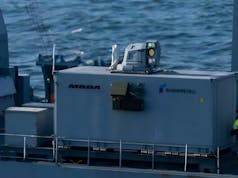A new report from the Council on Geostrategyhighlights the urgent need for revitalising Britain’s maritime industries to drive innovation, boost economic growth, and enhance national security.
The Sea Power Laboratory Primer, authored by Dr Emma Salisbury, outlines several key recommendations for His Majesty’s Government (HM Government) to overcome barriers and unlock long-term opportunities for British maritime success.
The Primer underscores the strategic importance of naval and commercial shipbuilding, port services, undersea infrastructure, and offshore renewable energy in maintaining Britain’s global competitiveness.
However, these sectors face significant challenges, including outdated facilities, a shortage of skilled workers, and gaps in maritime-specific training. To address these issues, the report calls for coordinated efforts across government departments and industry stakeholders.
Dr Salisbury emphasised the urgency of action, stating: “Reinvigorating these once-mighty industries would be valuable for promoting not only national security, but also a stronger British economy and the prosperity of communities around shipyards, ports, and maritime manufacturing sites around the country.”
The report suggests the creation of a Maritime Skills Passport and a comprehensive workforce plan to address labour shortages and skill development in the maritime sector.
Government contracts for shipbuilding should prioritise innovation, sustainability, and manufacturing growth, the Primer contends, with a focus on closer collaboration within the National Shipbuilding Office. Dr Salisbury added: “HM Government should grasp the considerable opportunities to rejuvenate the whole British maritime-industrial base, from shipbuilding to ports to offshore energy and beyond. A Britain with a sustainable and revitalised maritime sector will be safer, stronger, greener, and more prosperous over the long term.”
Increased government demand, sustained investment in research and development, and improved collaboration between departments—including the Ministry of Defence, Department of Business and Trade, and HM Treasury—are seen as vital components for success.
The report highlights the potential for British shipyards to drive both economic and defence-related gains if long-term commitments to domestic shipbuilding are secured.













It always concerns me when people in cities like London think it would be great if people in cities like Newcastle, Glasgow and Belfast get trained up in a industry that’s notoriously perilous and has extremely low productivity and GVA metrics to tick some box of national pride.
Shipyards don’t drive economic growth, go to Japan and South Korea and see the effect on an advanced economy of heavy industry past its prime.
We should build warships that we ourselves are prepared to buy and that’s it.
Get rid of this nonsense idea that the UK can export ships or build low end commercial vessels like Ferry’s, we can’t and all it does it devastates the same places that have had to put up with this nonsense for a century.
And yet we’re on the cusp of exporting the T26 to Norway!!! Go figure :).
And you seem to forget that even if we export a design, because the design incorporates loads of UK made assemblies and components there’s a huge down stream supply chain benefit. And that’s where the money is, not in welding bits of steel together but the complex components and assemblies, which then creates an after market spares, service and support benefit which is usually larger than the original contract to supply the parts in the first place. So we absolutely must build vessel other want to build or buy.
It depends on how much tech you use to make the ships.
One of the advantages of starting again from scratch and having a labour shortage is that we are going full pelt at automation in a way that would have been unthinkable in the 1990’s.
I fully agree that we have exported the T26 and T31 designs to other countries and QEC was seriously looked at too.
As you correctly say the supply chain of the high value precision engineering bits is where the value add is.
But if we don’t build complex ships in volume that bit of high value precision engineering will die.
So to go full circle to @Jim’s opening comment. The margins on high end naval ship building are actually quite good as it isn’t at commodity levels. That is more debatable at the T31 end of the market where a large barge is being built with fewer weapons systems fitted from the off.
Yep. T 31 with imported engines, CMS and guns.
With T31 is was alluding to fabrication approach.
On T31 the engines and guns are made by subsidiaries of Rolls-Royce and BAE, so not entirely foreign.
[ 𝐎𝐧𝐥𝐢𝐧𝐞 𝐁𝐫𝐚𝐧𝐝𝐞𝐝 𝐏𝐫𝐨𝐝𝐮𝐜𝐭𝐬 𝐖𝐢𝐭𝐡 𝐂𝐡𝐞𝐞𝐩𝐞𝐫 𝐏𝐫𝐢𝐜𝐞𝐬]
Every type of Men Fashion, Women Fashion and Kid Fashion are available here. Iphone mobile covers, hoodies, trousers with all size and colors are available here with much better and in cheaper prices.
So visit my store and get best
collection here…. Check MY Name
Yes, we might secure a small frigate order, the only one in fifty years and I emphasise might. Somehow I can’t see me recommending my son to go into ship building in the UK.
I agree the money is not in welding bits of steel together. The design work is done where exactly? Certainly not in Belfast. I believe it’s done in Bath high end southern based design jobs requiring people in the north to build skills in badly paid manufacturing jobs. This is why the country is imbalanced.
I suggest you go and look at the car parks in the ship yards.
You will gulp at the number of expensive cars there are….Barrow for a great example!
Report back and let me know if you think the roles are ‘low wage’……
Yes, you will note I left Barrow out, Barrow has guaranteed work for decades and building SSN’s is one of the hardest things to do on the planet. Barrow also has much of the design staff located there. Few if any live in Barrow because the town itself still suffers from the historic ship building legacy being one of the most deprived areas in the UK.
Belfast is a very different story. It’s taking on thousands of young workers to assemble steel blocks for ships designed in Bath and constructed in Spain, there are just three ships ordered and little chance of any follow on work. Even if there is follow on work it will be for three MRSS which will stave off closure at the yard for 6 years at most.
I’m all for us building our own warships with our own money. I’m just against pretending that we can do anything else. All we are doing is setting vulnerable communities up for a fall and tricking young people in to dead end careers. There is zero appetite in the UK government on either side for a larger navy and no need for three yards to support the surface fleet.
There is no chance the UK can build a successful commercial ship building industry as this article outlines.
It’s a fantasy.
Small frigste order? The T26 is going to cost 1 billion each and they need a minimum of 5!!!
On salaries that’s back to investment in higher productivity. It always the case that those who can program and maintain high end manufacturing kit get paid more than those who did the job it replaced.
That’s 5 frigates for export in 50 years, that’s not an industry even if they do cost £1 billion each and much of that billion won’t go anywhere near Glasgow.
In part I see the point you are making Jim. However, ships are not going away and we have an obsolete Royal Navy – or, at least – a very lopsided one. The problem is, these reports come and they go without that much happening that is of a long term thought through strategy. Is there anyone left in lighyy who thinks we have a national interest focussed civil service leave alone government?
lightyy? Blighty
What happened to the edit button (Leave my eyesight out of this!)
Haha Barry- you are unwittingly writing “Sarf Efrican ” slang. A lighty here is a young inexperienced lad who generally knows very little 🙂
Exactly this depressing negativity about Britain has become endemic just as ignoring the reasons we lost so much of our industry in the first place was endemic at the time, sadly just two sides of the same mentally debilitating negative coin. No one is saying Britain will become a major commercial ship builder again, that ship has literally sailed but there is no reason why we can’t become a specialist builder to take advantage of our enormous indigenous and innovative design talent. Geez we have in this Country the most prestigious and respected civil engineering company in the World which is behind so many of the great buildings in the World, we dominate F-1 design and engineering and we are at the forefront of aviation airframe and engineering design and yet we write off any capability to become a contributor to marine engineering despite having one of the prime locations for wind and wave power.
That expertise should as this report says be developed from design where are already strong to development and production where feasible so that unlike with wind turbines presently we have one of the highest per capita exploitation of the technology with virtually no indigenous design and construction in the sector so that the companies who knock them together here (if we are lucky) use our on/off shore developments as a showcase for their skills to gain new contracts in the likes of Kazakhstan with no benefit whatsoever to the uk. We simply cannot afford this wasteful use of national assets, potential and creativity for foreign profit. Geez if Britain being it seems virtually the only Country that has a trade deficit with the US (by US measures anyway) yet still have a President there who claims it’s still unbalanced in our favour isn’t a warning then I don’t know what is.
There are massive potential infrastructure and specialist opportunities at sea becoming available over the following decades and as with our other existing specialist engineering expertise we need to at least be in the game or we have no chance of generating wealth and security in a cut throat World like Trump just wanting to exploit and strip others to generate more profit for their own oligarchs.
Everyone negatively even in the US said that competing with Intel was madness then this little old uk company came along and yes it took decades but managed to totally overturn the silicon chip business and now the US not only lost its total domination of the sector but Intel is little more than a joke. We have to be nimble and innovative and then committed and with care we can take a bite out of even seemingly embedded sectors and hopefully try to hold not the profits generated. The satellite arena is yet another arena we saw the opportunity and as a result are prominent in the cube sat segment. All these successes lead to connected opportunities which we also need to exploit, something we have been very poor at.
In the end if the governments for the last 30 years had actually ordered warships on time and to the numbers required for the RN we would have a very large and capable ship building industry.. out own orders would be plenty if they were needed and not hashed up
The reality is the RN should have a single 20 strong frigate force, 10 AAW destroyer force 15 patrol and mine warfare ships, 6 littoral strike vessels…replaced every 20-25 years
That’s plenty of warships to keep 3 yards running.. then you have the mass and capacity that if someone wants 2-4 frigates you just flog them off your open production slots.. just like the Italians keep doing.
I too arrive at a minimum number of 30 escorts in an ideal world. The problem is that it is not remotely affordable on 2% of GDP.
The cost of a modern warship has trebled, quadrupled or more since the days of T21, T22 and County class destroyers. We are spending well under half of what we were in the Falklands era. Result is an inevitable.sizeable shrinkage in hull numbers. We are not alone in this. Looking at the main NATO-E navies, nobody has 30 escorts any more.
Uk – 19 planned, if no further cuts
Turkey – 17, none of them new or high end
France – 16 planned (reduction from current 22, with replacement of Floreals by the new Euro Patrol Corvette)
Italy – 13
Spain – 11
The days of the RN sailing the high seas and projecting.British force are behind us now, higher priorities are air and land forces, including missiles, UAVs, GBAD etc for the European and Atlantic theatres. The current budget for new warships would I reckon stretch to 16 T31, T26 and T83 over a 24-year cycle, if we can build them to last that long.
One naval trend that we should follow, which all the other navies above are acquiring, are well-armed corvettes to take on patrol and littoral defence. The Euopean Patrol Corvette.will be a 3,000 tonne light frigate, , well-armed with air defence and S2S missiles. Probably at least as capable as the T31, but with a lower price tag..
Your numbers are wrong for Italians. Will have 2 DDX, 2 Horizons, 12 FREMM, 7 PPA – that is 23 , plus eventually 4 EPC corvettes.
I disagree Alex. The list above sets out escorts, viz destroyers and frigates, aka major warships. You are adding in light frigates and corvettes, aka minor warships.
Italy currently has 13 escorts (2 Orizzonte DD, 1 Durand de la Penne DD, 8 FREMM FF, 2 Maestrale FF). That will increase to 16 , with 2 DDX and 4 FREMM on order and 3 older escorts being retired.
The list does not include light frigates, corvettes or OPVs. The 7 PPA you include (actually 10 are planned) are not escorts, they are classed as OPVs but we would probably term them corvettes.
Cripes – i agree with Alex,i too checked your numbers for Italy and found them to be short.The PPA are OPV’s in name only,they are Combat capable Frigates and have already been deployed as such.While lacking in VLS Capacity they have Sensors equivalent to and in some case superior to the FREMM Frigates,and they are set up to do ASW if needed.
Please tell me in what PPA 6200t full load is inferior to T31? all of them will have VLS btw.
And 10 are not planned anymore.
Exactly if the Italians with vision can do it then we could and should have too in recent decades but while there is plenty of vision and expertise at usual down the line, those at the top be it management or politics, seldom see it or if they do fail to have the confidence to back it. That’s bad enough but as you say when you add the stupidity inherent in not ensuring a consistent ongoing plan that constructors of anything can have confidence in then whatever the underlying competence it will and indeed almost entirely was lost.
We always seem to need a crisis rather than a plan to deliver of our best, just look at Gravehawk and other innovations we are creating for Ukraine it seems it’s the only way we allow free reign to our inherent talent.
Got to love all these report about UK maritime industry, they make it look like its in bad shape. But take the south coast of England there’s 2 boat builders collectively producing £700m of boats every year, that’s about 2 T31s or over 1 FSS by value, so by value annually these boat yards produce more new product than Rosyth by some margin I would think also the Clyde yards and they do this without any government help, intervention or orders, in fact they rely mostly on export orders!!!
Which 2 would those be? Sunseeker in Poole, and who else?
There are also several small yards building workboats and CTVs for the offshore industry, especially around Cowes, with Diverse marine and Wight Shipyard Co.
Princess yachts, its bigger than Sunseeker.
Re-vitalise the high-value supply-chain. Not much needs to be done to the yards which isn’t already in hand. I know MTU are assembling engines for BOXER in England now, is any naval engine work done here? Shafts and propellers all made abroad now, lots of electricals too. It feels like we’re slowly doing less and less radar and sonar work? Those are the high-value and high sovereignty-risk areas we should be focussing on, not re-opening another yard that can’t be sustained, as I fear will happen with Belfast.
Problem with radar and sonar is that someone has to order something sometime….
RN combatants fleet is now so small. BAE have 7 sets of SAMPSON and 10 sets of ARTISAN [8 T26 and 2x QEC] down from 17 sets [13 T23 + 2x Albion + 2x QEC] not long ago.
The issue is that sustaining an upgrade pathway per set gets eye watering expensive with that kind of drop in deployed numbers.
This is where short term savings on hull numbers are buying as the upgrade and sustainment costs won’t be much different as you need the same software and hardware teams to develop an upgrade for one unit or twenty units.
We would have a very good ship building industry if the RN, MOD and treasury actually bothered to order the ships needed.
The RN should never have dropped below
20 frigates of a common type
10 destroyers
15 patrol and mine warfare ships
6 littoral strike/amphibious vessels
2 carriers
That’s 5 programs that should have keep 3 yards churning out ships on a constant basis.. with easy opportunities to flog ships straight of the production slots.. because the RN was full equipped with new hulls.
I can’t last remember when RN had 20 of any combatant of a common type?
Highest I can remember are 16 x T23?
Before it all went to shit, it was looking at 20 common type frigates..10 with a GP load and 10 ASW, it even as a most conservative option was assessing making the whole fleet essentially 30 type 45 variants.. 10 AAW destroyer T45s, 10 decked out as GP Frigates with reduced radars ect and 10 with quite hulls and towed arrays..
Largest RN programme was the Type 12 ( type12, type12m and type 12l ) programmes with 39 frigates built between 1953 and 1973…so the RN can do a long term high hull numbers building programme.
Type 12 was of a different era of smaller simpler ships and matelots who would sleep in a hammock!
The T45 variant proposal was never a particularly serious idea. Anybody who has done 5 mins of naval architecture would tell you why – the hull is fundamentally wrong for ASW.
That’s an interesting point that I haven’t heard before SB. I’m trying to think why the T45 hull shape would be sub optimal for ASW. A line of explanation would be gratefully received!
Should of done this before our skills were destroyed by our governments in the last four decades.
Good points
Ridiculous. Shipbuilding gives very low money.
Fincantieri SpA the biggest western world shipyard revenue 7B$
Ferrero SpA. (Nutella makers) 11B$
Nvidia 60B$
Google 350B$
So, because it might only add a few billion rather than tens or hundreds of billions, we shouldn’t bother?
Using that same logic, Tempest will only bring a couple of billion, max, into our economy, so why bother with that? Might as well go in on the Franco/German FCAS, or join into the US NGAD programme like we did with the F-35. The Orange One would be delighted to have us invest in American military tech!
Why bother with Typhoon sales, or sales of any other of our military tech?
A lot of small things add up. If we invest in our shipbuilding capability, for starters we could end up with a larger, stronger and more potent Royal Navy. Our shipbuilders might even get some export orders – small numbers but still, it’s all money from other countries, into our own economy. All we need to to is invest more money into defence, with a view to expanding the Royal Navy – which everyone here thinks is necessary.
More money to the RN means more hulls ordered, meaning the shipbuilders are revitalised and their work continues, if not expanding. Larger orders allow for efficiencies of scale, meaning cheaper ships, making exports look more attractive. Even if we only end up selling half a dozen frigates, it’s better than no order and is just a nice Brucie Bonus for the economy, on top of the real benefit of a more powerful Royal Navy.
I did not say that, i said that is a drop so small that is not crucial for growth
“In 2024-25, we expect public spending to amount to £1,276.2 billion”
And I said that those drops add up.